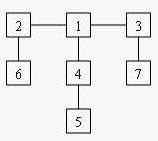poj1655 Balancing Act
阿新 • • 發佈:2017-09-28
can 可能 樹的重心 test sam example center trees esp
For example, consider the tree:

Deleting node 4 yields two trees whose member nodes are {5} and {1,2,3,6,7}. The larger of these two trees has five nodes, thus the balance of node 4 is five. Deleting node 1 yields a forest of three trees of equal size: {2,6}, {3,7}, and {4,5}. Each of these trees has two nodes, so the balance of node 1 is two.
For each input tree, calculate the node that has the minimum balance. If multiple nodes have equal balance, output the one with the lowest number.
---恢復內容開始---
Balancing Act| Time Limit: 1000MS | Memory Limit: 65536K | |
| Total Submissions: 14582 | Accepted: 6192 |
Description
Consider a tree T with N (1 <= N <= 20,000) nodes numbered 1...N. Deleting any node from the tree yields a forest: a collection of one or more trees. Define the balance of a node to be the size of the largest tree in the forest T created by deleting that node from T.For example, consider the tree:

Deleting node 4 yields two trees whose member nodes are {5} and {1,2,3,6,7}. The larger of these two trees has five nodes, thus the balance of node 4 is five. Deleting node 1 yields a forest of three trees of equal size: {2,6}, {3,7}, and {4,5}. Each of these trees has two nodes, so the balance of node 1 is two.
For each input tree, calculate the node that has the minimum balance. If multiple nodes have equal balance, output the one with the lowest number.
Input
Output
Sample Input
1 7 2 6 1 2 1 4 4 5 3 7 3 1
Sample Output
1 2
題意大概就是給你一棵樹,讓你找樹的重心。*樹的重心:在一顆樹中找到一個節點,這個節點的最大子樹相對於其他節點的最大子樹最小,該節點就是樹的重心。刪去重心,生成的一堆樹盡可能平衡。
思路大概就是dfs遍歷每一個點,然後找到該點的最大子樹,不斷更新擁有最小的最大子樹的節點。
代碼如下:
1 #include<cstdio> 2 #include<cstring> 3 #include<algorithm> 4 #define maxn 20010 5 #define mmst(x,y) memset(x,y,sizeof(x)) 6 using namespace std; 7 int son[maxn],size,ans,T,n,ecnt,head[maxn]; 8 bool vis[maxn]; 9 struct edge 10 { 11 int u,v,next; 12 }E[maxn*2]; 13 void add(int u,int v) 14 { 15 E[ecnt++].u=u; 16 E[ecnt].v=v; 17 E[ecnt].next=head[u]; 18 head[u]=ecnt; 19 } 20 void dfs(int u) 21 { 22 vis[u]=1; 23 son[u]=0; 24 int tmp=0; 25 for(int i=head[u];i;i=E[i].next) 26 { 27 int v=E[i].v; 28 if(vis[v]) continue; 29 dfs(v); 30 son[u]+=son[v]+1; 31 tmp=max(tmp,son[v]+1); 32 } 33 tmp=max(tmp,n-son[u]-1); 34 if(tmp<size||tmp==size&&u<ans) 35 { 36 size=tmp; 37 ans=u; 38 } 39 } 40 void clr() 41 { 42 mmst(son,0); 43 mmst(head,0); 44 mmst(vis,0); 45 ecnt=0; 46 ans=size=0x3f3f3f3f; 47 } 48 int main() 49 { 50 scanf("%d",&T); 51 while(T--) 52 { 53 clr(); 54 scanf("%d",&n); 55 for(int i=1;i<n;++i) 56 { 57 int a,b; 58 scanf("%d%d",&a,&b); 59 add(a,b); 60 add(b,a); 61 } 62 dfs(1); 63 printf("%d %d\n",ans,size); 64 } 65 }
poj1655 Balancing Act
